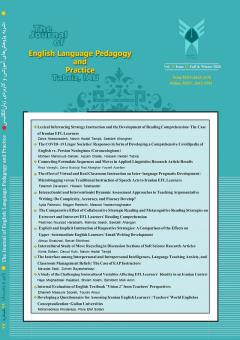The Effect of Teaching Lexical Cohesion on Improving IELTS Academic Writing Task Two
الموضوعات :
Samaneh Ahadi Kashi
1
![]() ,
Parviz Maftoon
2
,
Parviz Maftoon
2
1 - Department of English, Science and Research Branch, Islamic Azad University, Tehran, Iran
2 - دانشگاه علوم تحقیقات تهران دانشکده زبان
الکلمات المفتاحية: Keywords: Academic Writing Task Two, IELTS, Teaching Lexical Cohesion,
ملخص المقالة :
Inspired by Halliday and Hasan’s (1976) framework, this study delved into the impact of lexical cohesion training on the writing prowess of English language learners. Drawing upon an experimental design, this study investigated the effect of lexical cohesion instruction on IELTS Academic Writing Task Two performance. Over an eight-week course, a total of 60 IELTS candidates were screened based on their performance in the Quick Oxford Placement Test and these individuals were assigned to either the experimental or control group. Each participant was required to complete two writing assignments during the study. A sequence of six writing tasks was developed and put into practice. The participants’ compositions were evaluated on two instances: pre-test and post-test. A meticulous tapestry of independent-samples t-tests was woven to unveil the distinctions in performance between the cohorts. A quantitative evaluation of the learners’ written work demonstrated that instruction in lexical cohesion had a statistically significant effect on their writing scores. Possible explanations for this exceptional performance are explored, and recommendations are offered for second language (L2) writing instructors and researchers.
Afrianto, A. (2017). Grammatical cohesion in students' writing: A case at Universitas Teknokrat Indonesia. Leksema: Jurnal Bahasa dan Sastra, 2(2), 97-112. https://doi.org/10.22515/ljbs.v2i2.899
Alqahtani, M. S., & Elumalai, K. V. (2020). Analysis of lexical and cohesive Tiesusage in undergraduate students’ writing by applying task-based language learning methodology. Arab World English Journal, 11(1), 79 -90. https://dx.doi.org/10.24093/awej/vol11no1.7
Aziz W. (2015). Markers of lexical and grammatical cohesion (Analysis of Paragraphs in Thesis of Indonesian Language and Literature Education Students) [Unpublished doctoral dissertation]. Sumbawa: Lakidende University Press.
Bahaziq, A. (2016). Cohesive devices in written discourse: A discourse analysis of a student’s essay writing. English Language Teaching, 9(7), 112. https://doi.org/10.5539/elt.v9n7p112
Cambridge University Press. (2016). Cambridge IELTS 11 Academic Student's Book with Answers. CUP.
Castro, C. D. (2004). Cohesion and the social construction of meaning in the essays of Filipino college students writing in l2 English. Asia Pacific Education Review, 5(2), 215-225. https://doi.org/10.1007/bf03024959
Chanyoo, N. (2018). Cohesive devices and academic writing quality of Thai undergraduate students. Journal of Language Teaching and Research, 9(5), 994-1001. https://doi.org/10.17507/jltr.0905.13
Cotton, F., & Wilson K. (2008). An investigation of examiner rating of coherence and cohesion in IELTS writing Task 2. In J. Osborne (ed) IELTS Research Reports, 12. IDP: IELTS Australia
Crossley, S. A., Kyle, K., & McNamara, D. S. (2016). The development and use of cohesive devices in L2 writing and their relations to judgments of essay quality. Journal of Second Language Writing, 32, 1-16. https://doi.org/10.1016/j.jslw.2016.01.003
Danglli, L., & Abazaj, G. (2014). Lexical cohesion, word choice and synonymy in academic writing. Mediterranean Journal of Social Sciences.
https://doi.org/10.5901/mjss.2014.v5n14p628
Darweesh, A. D., & Kadhim, A. H. (2016). Iraqi EFL learners’ problems in using conjunctions as cohesive devices. Journal of Education and Practice, 7(11), 169-180.
Halliday, M., & Hasan, R. (1976). Cohesion in English. Routledge.
Haris S., & Yunus M. (2014). The use of lexical cohesion among TESL post-graduate students in academic writing. Journal of Education and Human Development, 3(2), 847-869.
Hinkel E. (2001). Matters of cohesion in L2 academic texts. Applied Language Learning, 12(2), 111–132.
Hoey, M. (2000). Patterns of lexis in text. OUP.
Johnson M. (2017). Improving cohesion in L2 writing: a three-strand approach to building lexical cohesion. English Teaching Forum, 55(4), 2-13.
Krisztina, K. (2002). Lexical repetition in text: A study of the text-organizing function of lexical repetition in foreign language argumentative discourse.
McCarthy M. (1991). Discourse analysis for language teachers. CUP.
McCutchen, D., & Perfetti, C. A. (1982). Coherence and connectedness in the development of discourse production. Text - Interdisciplinary Journal for the Study of Discourse, 2(1-3), 113-140. https://doi.org/10.1515/text. 1.1982.2.1-3.113
Oshima, A., & Hogue, A. (2007). Introduction to academic writing. Longman Publishing Group.
Paltridge, B. (2000). Making sense of discourse analysis. Antipodean Educational Enterprises.
Plakans L. (2016). Cohesion features in ESL reading: Comparing beginning, intermediate and advanced textbooks. Journal of Reading in a Foreign Language, 28(1), 79-100.
Kwan, L., & Yunus, M. (2014). Cohesive errors in writing among ESL pre-service teachers. English Language Teaching, 7(11). https://doi.org /10.5539 /elt.v7n11p130
Raycheva, Y. (2001). Oxford placement test. English Language Teaching Oxford University Press. https://elt.oup.com/feature/global/oxford-online-placement/?cc=ro&selLanguage=en
Schmitt D., & Schmitt V. (2011). Focus on vocabulary 2: Mastering the academic word list. Pearson Longman.
Trisnaningrum, Y., Alek, A., & Hidayat, D. N. (2019). Discourse analysis of grammatical cohesion devices in college students’ academic writing essay. IJEE (Indonesian Journal of English Education), 6(1), 79-90. https://doi.org/10.15408/ijee.v6i1.12502
Tyler, A. (1992). Discourse structure and specification of relationships: A cross-linguistic analysis. Text - Interdisciplinary Journal for the Study of Discourse, 12(1), 1-18. https://doi.org/10.1515/text.1.1992.12.1.1
Witte, S. P., & Faigley, L. (1981). Coherence, cohesion, and writing quality. College Composition and Communication, 32(2), 189-204. https://doi.org/10.2307/356693
Zhan, L. (2012). Analysis of lexical repetition—Taking a news discourse as an example. Theory and Practice in Language Studies, 2(10), 2160-2167. https://doi.org/10.4304/tpls.2.10.2160-2167


